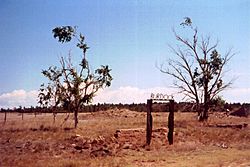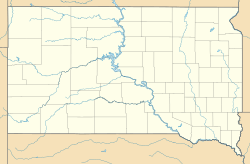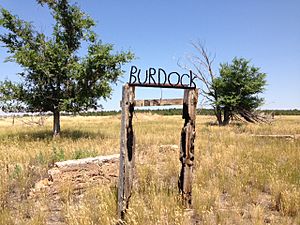Burdock, South Dakota facts for kids
Quick facts for kids
Burdock, South Dakota
|
|
|---|---|

Wire on wood sign marking the location of Burdock
|
|
| Country | United States |
| State | South Dakota |
| County | Fall River |
| Township | Argentine |
| Elevation | 3,642 ft (1,110 m) |
| Population
(2010)
|
|
| • Total | 0 |
| Time zone | UTC-7 (MST) |
| • Summer (DST) | UTC-6 (MDT) |
| Area code(s) | 605 |
| FIPS code | 46-8590 |
| GNIS feature ID | 1265622 |
Burdock is an uninhabited ghost town in Argentine Township in Fall River County, South Dakota, United States. A ghost town is a place where people used to live and work, but now no one does.
The name Burdock has an unclear origin. No one is quite sure how it got its name.
Contents
Where is Burdock?
Burdock is located where two roads meet: Fall River County Highway 6463 and Township Road B. A train track, part of the BNSF Railway, runs alongside the county highway.
Burdock's closest neighbors are Dewey to the northwest and Edgemont to the southeast. The border with Wyoming is just three miles to the west. The Black Hills National Forest surrounds the area, extending about three miles to the north, east, and south. Burdock is also just southwest of the Elk Mountains, which are a small part of the Black Hills. You can find Burdock on both the South Dakota highway map and the Black Hills National Forest map.
What was Burdock known for?
Burdock became important because of uranium. This valuable mineral was discovered in the area in 1952.
Early Uranium Mining
Mining for uranium started as early as 1954. A local group called Triangle Mining Co. was one of the first to dig here. They were a part of Edgemont Mining Co.
At first, they used a simple method called an open pit mine. This means they dug a large hole from the surface. Triangle Mining also dug tunnels, called adits, into a ridge to reach a narrow vein of uranium.
Later Mining and Future Plans
Around 1960, another company, Susquehanna Western Corp, found more uranium close to the surface. This led to more open pit mining in five or six different pits. These pits were not very deep, less than 100 feet. It's estimated that about 200,000 pounds of uranium oxide were produced during this time. Uranium oxide is a processed form of uranium.
More recently, in early 2012, a company called Powertech (USA) Inc. (now Azarga Uranium Corp.) proposed to start mining again. They submitted their plans to the U.S. Bureau of Land Management.



